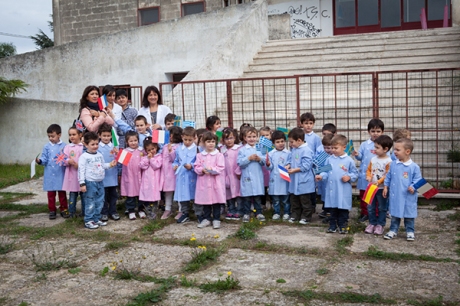When I woke up this morning it was snowing whirling dervish flakes. God! It’s nearly Easter too. Poor Suggs and Co: stirling performance last night at the sad closure of BBC Television Centre in Wood Lane. I thought back to those warm, balmy days on the Grundtvig Project, longing for soothing Negroamaro wine and the succulent dishes we tried.
(Cue: one of those wobbly dream filters they used to use in the movies.)

We are visiting the Monaci family vineyards in Copertino, Salento. Originally from Campania, the family moved to the Puglia region 50 years ago. Our speaker is Angela Venturi, wine and PR expert specialising in wine making and high quality agricultural tours. Spanning 22 hectares, this masseria focuses on red grapes (Negroamaro, Primitivo, Black Malvasia) trained to grow flat on espaliers (trellis) making the fruit easier to harvest. (A plant’s lifespan is 25-30 years.) This plant is hardy. In 2007 temperatures reached 52 degrees – a great year for red grapes, Angela waxed enthusiastically.
The Monacis never buy in grapes for blending and follow a policy of respecting the soil by not forcing growth. Nevertheless, 100,000 bottles is usual for a good year. Young and white grapes need to be protected from the sun, which can be ferocious in these parts, so vines are planted so that the fruit is protected by the shadow of its own leaves. Nowadays, Antonio cares for the plants while Adriano lays down the law in the factory.
Harvesting 80% by hand, usually takes place late August – early October and sugar content of the grape on average 21-22%. This year sugars weighed in at a whopping 27% – and so expectations were high. Timing is critical as each day you leave the grape, the sugar content changes and the flavour is corrupted. Early harvesting hours protects both the grape and the workers and is over by 11am due to the extreme heat in this region.
-

-
Angela, Wine Expert, Explains
-

-
Patrick samples the grape
-

-
Adriano and Antonio
-

-
The Spanish Contingent
-

-
The Macerator
-

-

-
Grundtvig colleagues listen intently
-

-
Then the wine is stored underground well away from light.
-

-
Fermentation tanks
-

-

-

-

-

-

-

-

-

-

-
Bottling up machines
-

-

-

The fruit is transported to the press, any hard wood and leaves left over are macerated and put back in the soil as compost. After 6-7 days in the fermentation machines (whose design dates back to the 40’s and provide a stable temperature) skins are removed, recycled and sold to be made into Grappa and surgical alcohol. Nothing is wasted here! The wine is then kept in huge vats under ground away from the light, at 16-18 degrees until ready for storing in barrels. 100% French Oak, they provide natural oxygenation without overcoming the wine’s true flavour, which in itself is strong enough. For 18 months it lays in the barrel and left for a further 10 months in the bottle to settle. “Simpotica” stays in French Oak Barrels for only 6 months.
Bottling
Bottles are received sterilised but are cleaned and re-sterilised to be sure. Great pains have been taken to ensure the quality of the natural cork used. Over the years, it was sourced from Salento, then Sardinia but nowadays it’s imported from Portugal. (Plastic doesn’t allow breathing, screw top proved a disaster!)
History
Salento has a long history of wine making. Byzantine monks, then the Normans and Frederick II improved the cultivation in the area. Exporting can be attributed to the Berbers. Unfortunately, all wine production in the region was destroyed by disease and had to be re-established in the 19th Century. Wineries from the North started buying grape from the South and due to mass production methods, quality suffered but nowadays, Puglia is the fourth region after Sicily producing quality wines.
(Cue: the wobbly dream filter again.)
It’s Still Snowing!
The care and attention that goes into making these lovely wines is something I’ll certainly remember! As I gaze out of my window, the snow hasn’t let up and I’m reticent to get out of my pyjamas and go shopping.





























































